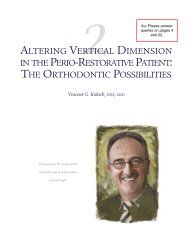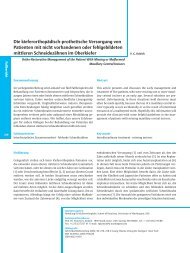Orthodontic and Nonorthodontic Root Resorption - Journal of Dental ...
Orthodontic and Nonorthodontic Root Resorption - Journal of Dental ...
Orthodontic and Nonorthodontic Root Resorption - Journal of Dental ...
You also want an ePaper? Increase the reach of your titles
YUMPU automatically turns print PDFs into web optimized ePapers that Google loves.
or a bonded lingual wire. But these teeth required<br />
restoration. In the third patient, no permanent retention<br />
other than a removal retainer was used for the<br />
patient. After thirteen years, the patient without a fixed<br />
retainer has retained her severely resorbed maxillary<br />
lateral incisors. However, this patient has a two-millimeter<br />
overjet in centric occlusion <strong>and</strong> does not have<br />
any parafunctional or destructive occlusal habits. I<br />
believe that parafunctional habits, crown mobility,<br />
<strong>and</strong> the need for restoration tend to determine the<br />
necessity for a permanent lingual splint. If a patient<br />
has a protrusive bruxing habit with mobile maxillary<br />
incisors <strong>and</strong> will require some sort <strong>of</strong> restoration <strong>of</strong><br />
these teeth, then perhaps splinting will help to avoid<br />
the negative effects <strong>of</strong> each <strong>of</strong> these parameters.<br />
If the patient requires further orthodontic<br />
treatment, will the roots continue to resorb? This<br />
research question has not been explored. However,<br />
most orthodontists have had to retreat patients who<br />
have had root resorption during an earlier phase <strong>of</strong><br />
orthodontic treatment. The three patients described<br />
in this article all had orthodontic treatment ranging<br />
in length from nine months to over two years, <strong>and</strong> the<br />
tooth movement was started after the root resorption<br />
had occurred. None <strong>of</strong> these patients exhibited any<br />
further root resorption as a result <strong>of</strong> the orthodontic<br />
retreatment. However, in these cases I tried to limit<br />
the amount <strong>of</strong> tooth movement, limit the length <strong>of</strong><br />
orthodontic treatment, <strong>and</strong> avoid intrusive tooth<br />
movements. Also, histologic follow-up after root<br />
resorption showed that reparative dentin <strong>and</strong> cellular<br />
cementum form after the tooth movement had ceased.<br />
Perhaps the presence <strong>of</strong> a cellular cemental layer<br />
plays some role in protecting the tooth root during<br />
orthodontic retreatment.<br />
Summary <strong>and</strong> Conclusions<br />
This article has described the treatment <strong>of</strong> three<br />
orthodontic patients who had experienced severe<br />
root resorption but required further orthodontics. All<br />
three patients had successful long-term outcomes by<br />
maintaining the severely resorbed roots. In addition<br />
to illustrating the logic <strong>of</strong> the treatment plans as well<br />
as the long-term effect, I have tried to answer the<br />
key questions that arise in the mind <strong>of</strong> the general<br />
dentist when he or she inherits a patient with severe<br />
postorthodontic or nonorthodontic root resorption.<br />
Hopefully, this information will be clinically useful<br />
for the general dentist <strong>and</strong> orthodontist when planning<br />
treatment for these difficult situations.<br />
REFERENCES<br />
1. Heimisdottir K, Bosshardt D, Ruf S. Can the severity<br />
<strong>of</strong> root resorption be accurately judged by means <strong>of</strong><br />
radiographs? A case report with histology. Am J Orthod<br />
Dent<strong>of</strong>acial Orthop 2005;128:106–9.<br />
2. Sameshima GT, Sinclair PM. Characteristics <strong>of</strong> patients<br />
with severe root resorption. Orthod Crani<strong>of</strong>acial Res<br />
2004;7:108–14.<br />
3. Smale I, Artun J, Behbehani F, Doppel D, van’t H<strong>of</strong> M,<br />
Kuijpers-Jagtman AM. Apical root resorption 6 months<br />
after initiation <strong>of</strong> fixed orthodontic appliance therapy. Am<br />
J Orthod Dent<strong>of</strong>acial Orthop 2005;128:57–67.<br />
4. Artun J, Smale I, Behbehani F, Doppel D, van’t H<strong>of</strong> M,<br />
Kuijpers-Jagtman AM. Apical root resorption six <strong>and</strong><br />
twelve months after initiation <strong>of</strong> fixed orthodontic appliance<br />
therapy. Angle Orthod 2005;75:919–26.<br />
5. Nigul K, Jagomagi T. Factors related to apical root resorption<br />
<strong>of</strong> maxillary incisors in orthodontic patients.<br />
Stomatologiia 2006;8:76–9.<br />
6. Moh<strong>and</strong>esan H, Ravanmehr H, Valaei N. A radiographic<br />
analysis <strong>of</strong> external apical root resorption <strong>of</strong> maxillary<br />
incisors during active orthodontic treatment. Eur J Orthod<br />
2007;29:134–9.<br />
7. Maltha JC, van Leeuwen EJ, Dijkman GE, Kuijpers-<br />
Jagtman AM. Incidence <strong>and</strong> severity <strong>of</strong> root resorption<br />
in orthodontically moved premolars in dogs. Orthod<br />
Crani<strong>of</strong>ac Res 2004;7:115–21.<br />
8. Owman-Moll P, Kurol J, Lundgren D. Effects <strong>of</strong> a doubled<br />
orthodontic force magnitude on tooth movement <strong>and</strong> root<br />
resorption: an interindividual study in adolescents. Eur J<br />
Orthod 1996;18:141–50.<br />
9. Owman-Moll P, Kurol J, Lundgren D. The effects <strong>of</strong> a<br />
four-fold increased orthodontic force magnitude on tooth<br />
movement <strong>and</strong> root resorption: an intra-individual study<br />
in adolescents. Eur J Orthod 1996;18:287–94.<br />
10. Kurol J, Owman-Moll P. Hyalinization <strong>and</strong> root resorption<br />
during early orthodontic tooth movement in adolescents.<br />
Angle Orthod 1998;68:161–5.<br />
11. Iino S, Sakoda S, Ito G, Nishimori T, Ikeda T, Miyawaki<br />
S. Acceleration <strong>of</strong> orthodontic tooth movement by alveolar<br />
corticotomy in the dog. Am J Orthod Dent<strong>of</strong>acial Orthop<br />
2007;131:448e1–448e8.<br />
12. Von Bohl M, Maltha JC, Von Den H<strong>of</strong>f JW, Kuijpers-<br />
Jagtman AM. Focal hyalinization during experimental<br />
tooth movement in beagle dogs. Am J Orthod Dent<strong>of</strong>acial<br />
Orthop 2004;125:615–23.<br />
13. Von Bohl M, Maltha J, Von Den H<strong>of</strong>f H, Kuijpers-Jagtman<br />
AM. Changes in the periodontal ligament after experimental<br />
tooth movement using high <strong>and</strong> low continuous forces<br />
in beagle dogs. Angle Orthod 2004;74:16–25.<br />
14. Owman-Moll P, Kurol J, Lundgren D. Continuous versus<br />
interrupted continuous orthodontic force related to<br />
early tooth movement <strong>and</strong> root resorption. Angle Orthod<br />
1995;65:395–401.<br />
15. Owman-Moll P. <strong>Orthodontic</strong> tooth movement <strong>and</strong> root<br />
resorption with special reference to force magnitude<br />
<strong>and</strong> duration: a clinical <strong>and</strong> histological investigation in<br />
adolescents. Swed Dent J Suppl 1995;105:1–45.<br />
16. Owman-Moll P, Kurol J. The early reparative process <strong>of</strong><br />
orthodontically induced root resorption in adolescents: location<br />
<strong>and</strong> type <strong>of</strong> tissue. Eur J Orthod 1998;20:727–32.<br />
August 2008 ■ <strong>Journal</strong> <strong>of</strong> <strong>Dental</strong> Education 901





